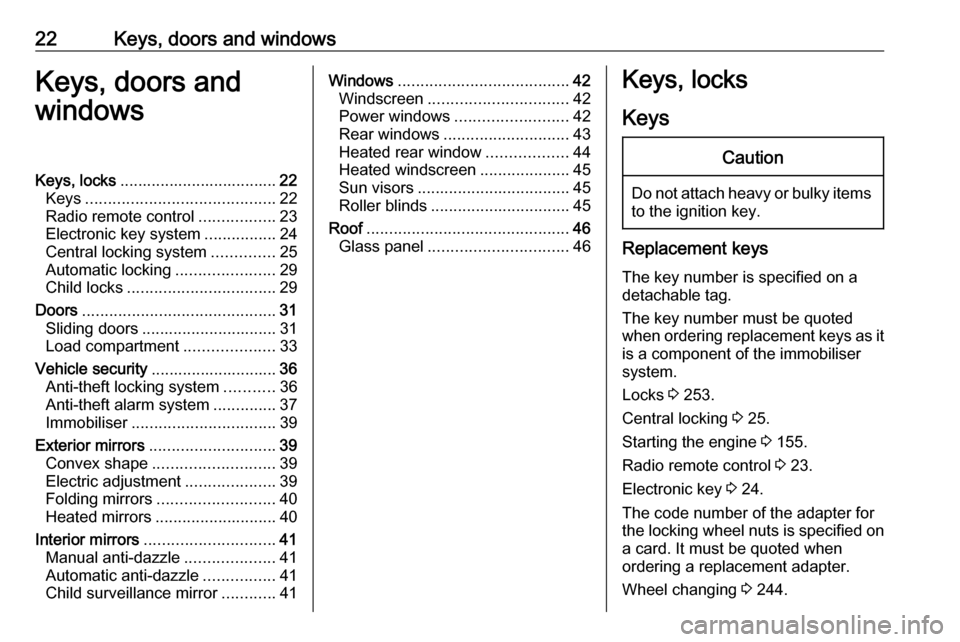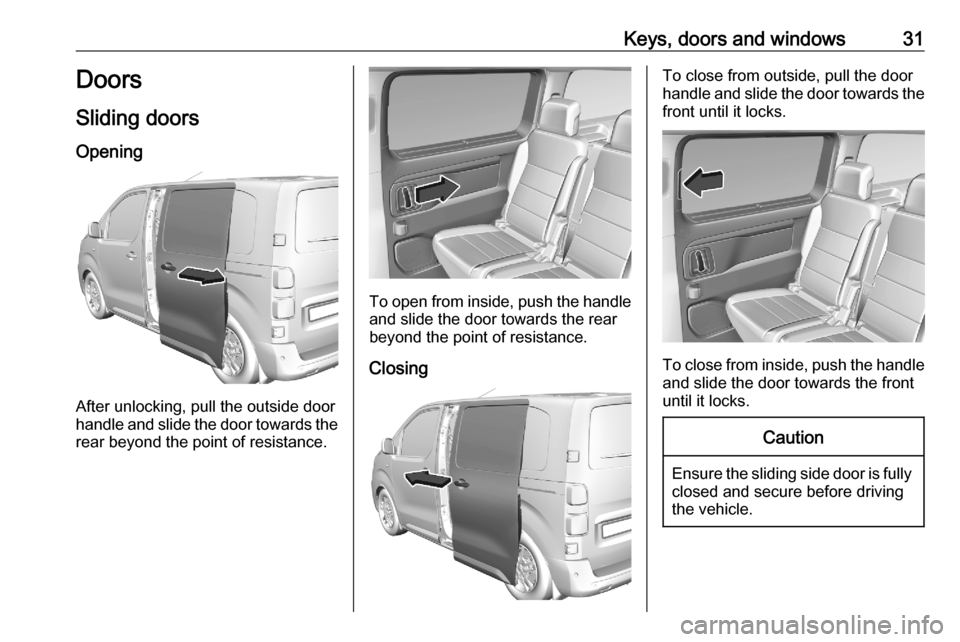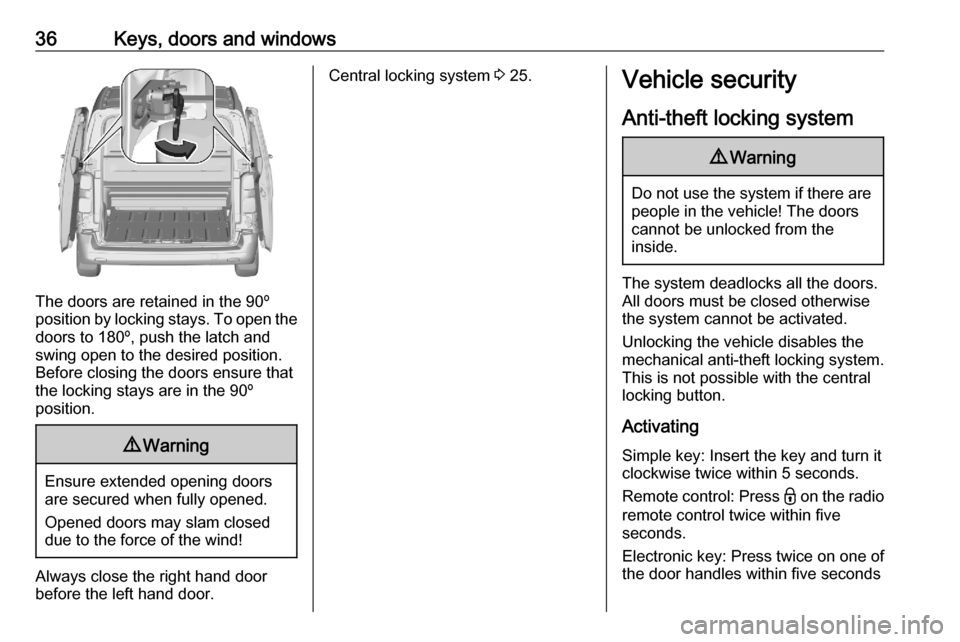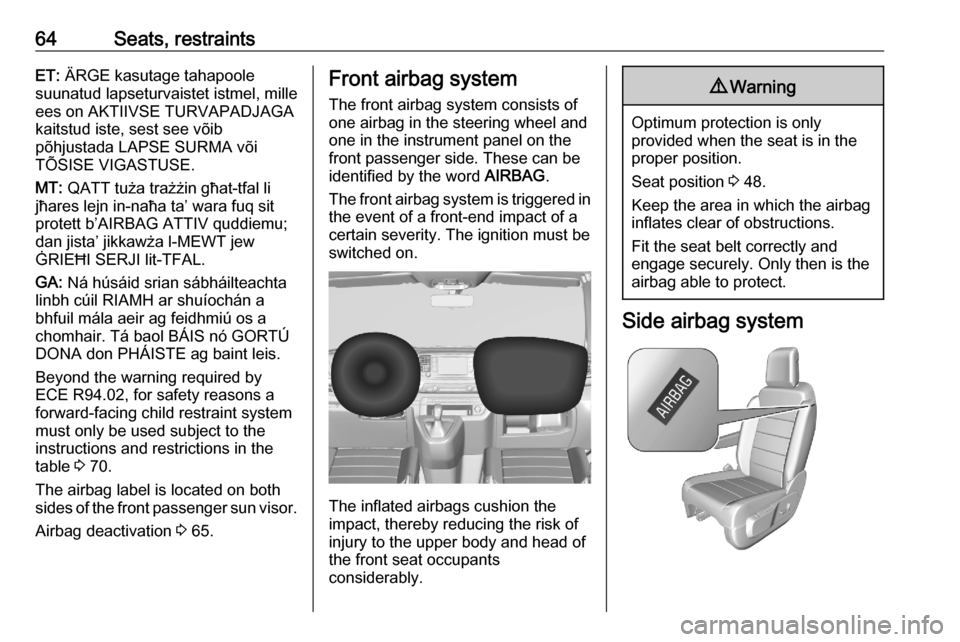ECU OPEL VIVARO C 2020.25 Manual user
[x] Cancel search | Manufacturer: OPEL, Model Year: 2020.25, Model line: VIVARO C, Model: OPEL VIVARO C 2020.25Pages: 287, PDF Size: 28.79 MB
Page 24 of 287

22Keys, doors and windowsKeys, doors and
windowsKeys, locks ................................... 22
Keys .......................................... 22
Radio remote control .................23
Electronic key system ................24
Central locking system ..............25
Automatic locking ......................29
Child locks ................................. 29
Doors ........................................... 31
Sliding doors .............................. 31
Load compartment ....................33
Vehicle security ............................ 36
Anti-theft locking system ...........36
Anti-theft alarm system ..............37
Immobiliser ................................ 39
Exterior mirrors ............................ 39
Convex shape ........................... 39
Electric adjustment ....................39
Folding mirrors .......................... 40
Heated mirrors ........................... 40
Interior mirrors ............................. 41
Manual anti-dazzle ....................41
Automatic anti-dazzle ................41
Child surveillance mirror ............41Windows ...................................... 42
Windscreen ............................... 42
Power windows ......................... 42
Rear windows ............................ 43
Heated rear window ..................44
Heated windscreen ....................45
Sun visors .................................. 45
Roller blinds ............................... 45
Roof ............................................. 46
Glass panel ............................... 46Keys, locks
KeysCaution
Do not attach heavy or bulky items to the ignition key.
Replacement keys
The key number is specified on a
detachable tag.
The key number must be quoted
when ordering replacement keys as it
is a component of the immobiliser
system.
Locks 3 253.
Central locking 3 25.
Starting the engine 3 155.
Radio remote control 3 23.
Electronic key 3 24.
The code number of the adapter for
the locking wheel nuts is specified on
a card. It must be quoted when
ordering a replacement adapter.
Wheel changing 3 244.
Page 33 of 287

Keys, doors and windows31Doors
Sliding doors
Opening
After unlocking, pull the outside door
handle and slide the door towards the
rear beyond the point of resistance.
To open from inside, push the handle and slide the door towards the rear
beyond the point of resistance.
Closing
To close from outside, pull the door
handle and slide the door towards the
front until it locks.
To close from inside, push the handle and slide the door towards the front
until it locks.
Caution
Ensure the sliding side door is fully closed and secure before driving
the vehicle.
Page 38 of 287

36Keys, doors and windows
The doors are retained in the 90º
position by locking stays. To open the
doors to 180º, push the latch and
swing open to the desired position.
Before closing the doors ensure that
the locking stays are in the 90º
position.
9 Warning
Ensure extended opening doors
are secured when fully opened.
Opened doors may slam closed due to the force of the wind!
Always close the right hand doorbefore the left hand door.
Central locking system 3 25.Vehicle security
Anti-theft locking system9 Warning
Do not use the system if there are
people in the vehicle! The doorscannot be unlocked from the
inside.
The system deadlocks all the doors. All doors must be closed otherwise
the system cannot be activated.
Unlocking the vehicle disables the
mechanical anti-theft locking system.
This is not possible with the central
locking button.
Activating
Simple key: Insert the key and turn it
clockwise twice within 5 seconds.
Remote control: Press - on the radio
remote control twice within five seconds.
Electronic key: Press twice on one of
the door handles within five seconds
Page 65 of 287

Seats, restraints63TR: Arkaya bakan bir çocuk emniyet
sistemini KESİNLİKLE önünde bir
AKTİF HAVA YASTIĞI ile
korunmakta olan bir koltukta
kullanmayınız. ÇOCUK ÖLEBİLİR
veya AĞIR ŞEKİLDE
YARALANABİLİR.
UK: НІКОЛИ не використовуйте
систему безпеки для дітей, що
встановлюється обличчям назад, на сидінні з УВІМКНЕНОЮ
ПОДУШКОЮ БЕЗПЕКИ, інакше це
може призвести до СМЕРТІ чи
СЕРЙОЗНОГО ТРАВМУВАННЯ
ДИТИНИ.
HU: SOHA ne használjon hátrafelé
néző biztonsági gyerekülést előlről
AKTÍV LÉGZSÁKKAL védett ülésen,
mert a GYERMEK HALÁLÁT vagy
KOMOLY SÉRÜLÉSÉT okozhatja.
HR: NIKADA nemojte koristiti sustav
zadržavanja za djecu okrenut prema
natrag na sjedalu s AKTIVNIM
ZRAČNIM JASTUKOM ispred njega,
to bi moglo dovesti do SMRTI ili
OZBILJNJIH OZLJEDA za DIJETE.
SL: NIKOLI ne nameščajte otroškega
varnostnega sedeža, obrnjenega v
nasprotni smeri vožnje, na sedež zAKTIVNO ČELNO ZRAČNO
BLAZINO, saj pri tem obstaja
nevarnost RESNIH ali SMRTNIH
POŠKODB za OTROKA.
SR: NIKADA ne koristiti bezbednosni
sistem za decu u kome su deca
okrenuta unazad na sedištu sa
AKTIVNIM VAZDUŠNIM
JASTUKOM ispred sedišta zato što DETE može da NASTRADA ili da se
TEŠKO POVREDI.
MK: НИКОГАШ не користете детско
седиште свртено наназад на
седиште заштитено со АКТИВНО
ВОЗДУШНО ПЕРНИЧЕ пред него,
затоа што детето може ДА ЗАГИНЕ или да биде ТЕШКО ПОВРЕДЕНО.
BG: НИКОГА не използвайте
детска седалка, гледаща назад,
върху седалка, която е защитена
чрез АКТИВНА ВЪЗДУШНА
ВЪЗГЛАВНИЦА пред нея - може да
се стигне до СМЪРТ или
СЕРИОЗНО НАРАНЯВАНЕ на
ДЕТЕТО.
RO: Nu utilizaţi NICIODATĂ un scaun
pentru copil îndreptat spre partea din
spate a maşinii pe un scaun protejat
de un AIRBAG ACTIV în faţa sa;acest lucru poate duce la DECESUL
sau VĂTĂMAREA GRAVĂ a
COPILULUI.
CS: NIKDY nepoužívejte dětský
zádržný systém instalovaný proti
směru jízdy na sedadle, které je
chráněno před sedadlem AKTIVNÍM
AIRBAGEM. Mohlo by dojít k
VÁŽNÉMU PORANĚNÍ nebo ÚMRTÍ
DÍTĚTE.
SK: NIKDY nepoužívajte detskú
sedačku otočenú vzad na sedadle
chránenom AKTÍVNYM AIRBAGOM,
pretože môže dôjsť k SMRTI alebo
VÁŽNYM ZRANENIAM DIEŤAŤA.
LT: JOKIU BŪDU nemontuokite atgal
atgręžtos vaiko tvirtinimo sistemos
sėdynėje, prieš kurią įrengta AKTYVI
ORO PAGALVĖ, nes VAIKAS GALI
ŽŪTI arba RIMTAI SUSIŽALOTI.
LV: NEKĀDĀ GADĪJUMĀ
neizmantojiet uz aizmuguri vērstu
bērnu sēdeklīti sēdvietā, kas tiek
aizsargāta ar tās priekšā uzstādītu AKTĪVU DROŠĪBAS SPILVENU, jopretējā gadījumā BĒRNS var gūt
SMAGAS TRAUMAS vai IET BOJĀ.
Page 66 of 287

64Seats, restraintsET: ÄRGE kasutage tahapoole
suunatud lapseturvaistet istmel, mille
ees on AKTIIVSE TURVAPADJAGA
kaitstud iste, sest see võib
põhjustada LAPSE SURMA või
TÕSISE VIGASTUSE.
MT: QATT tuża trażżin għat-tfal li
jħares lejn in-naħa ta’ wara fuq sit
protett b’AIRBAG ATTIV quddiemu;
dan jista’ jikkawża l-MEWT jew
ĠRIEĦI SERJI lit-TFAL.
GA: Ná húsáid srian sábháilteachta
linbh cúil RIAMH ar shuíochán a
bhfuil mála aeir ag feidhmiú os a
chomhair. Tá baol BÁIS nó GORTÚ
DONA don PHÁISTE ag baint leis.
Beyond the warning required by
ECE R94.02, for safety reasons a
forward-facing child restraint system
must only be used subject to the
instructions and restrictions in the
table 3 70.
The airbag label is located on both
sides of the front passenger sun visor.
Airbag deactivation 3 65.Front airbag system
The front airbag system consists of
one airbag in the steering wheel and
one in the instrument panel on the
front passenger side. These can be
identified by the word AIRBAG.
The front airbag system is triggered in
the event of a front-end impact of a
certain severity. The ignition must be
switched on.
The inflated airbags cushion the
impact, thereby reducing the risk of
injury to the upper body and head of
the front seat occupants
considerably.
9 Warning
Optimum protection is only
provided when the seat is in the
proper position.
Seat position 3 48.
Keep the area in which the airbag
inflates clear of obstructions.
Fit the seat belt correctly and
engage securely. Only then is the
airbag able to protect.
Side airbag system
Page 71 of 287

Seats, restraints69The following child restraints arerecommended for the following
weight classes:
● Group 0+ :
Römer Baby-Safe Plus installed
in the rearward facing position
with or without ISOFIX base for
children up to 13 kg
● Group I :
RÖMER Duo Plus ISOFIX with or without ISOFIX and Top-tether
for children from 9 kg to 18 kg
● Group II, Group III :
Römer Kidfix XP with or without
ISOFIX for children from 15 kg to
36 kg
The child is restrained by the seat belt.
The installation is permitted only
on the outer rear seats. The head restraint has to be removed.
● Group II, Group III :
Graco Booster for children from
15 kg to 36 kg
The child is restrained by the seat belt.The installation is permitted on
the front passenger seat or the
rear seats.
Ensure that the child restraint system to be installed is compatible with the
vehicle type.
Ensure that the mounting location of
the child restraint system within the
vehicle is correct, see following
tables.
Allow children to enter and exit the
vehicle only on the side facing away
from the traffic.
When the child restraint system is not in use, secure the seat with a seat beltor remove it from the vehicle.
Note
Do not affix anything on the child
restraint systems and do not cover
them with any other materials.
A child restraint system which has
been subjected to stress in an
accident must be replaced.
Page 84 of 287

82StorageLashing eyes
The lashing eyes are designed to
secure items against slippage, e.g.
using lashing straps or luggage net.
Lashing eyes may be located on the
vehicle floor. The number and
location of the lashing eyes may vary depending on the vehicle.
Cargo management system
Flap behind the passenger seat Depending on version, a partition
behind the front seats protects the
driver and front passengers against
the risk of load movement.
There may be a flap in the partition
behind the passenger seat which can
be removed to accommodate long
objects.
If the outer passenger seat is folded
and the flap is open, the centre seat
has to stay free.
Removing the flap1. Release the locking device, lower
the flap and then remove it.
2. Stow the flap behind the driver’s seat.
Turn the locking device upwards.
Put the hinges of the flap in their
housing, lift the flap and close the
locking device.
Page 88 of 287

86Storage
It is possible to install the safety
net together with folded seats.
Folded seats 3 53.
2. Tension both straps by pulling at the loose end.
Safety net on the floor
Attached to the lashing eyes on the
rear floor, it allows objects to be held down.
Lashing eyes 3 82.
Additional storage
features
Folding tray
Trays may be located on the
backrests of the front seats.
Fold down the tray. The tray contains a cupholder and a strap to secure
objects.
Do not place any hard or heavy
objects on the tray.
Page 89 of 287

Storage87Document tray in the centre
seatback
The front centre passenger seat
backrest can contain a document
tray.
Fold down the tray. The document
tray contains a storage compartment
and a swivelling shelf.
Return the swivelling shelf to its
original position before raising the tray.
Table
Multifunctional table
The multifunctional table can be
positioned in second or third row.
To move the multifunctional table pull the handle in the front without going
beyond the point of resistance. Slide
the multifunctional table forwards or
backwards. Release the handle when it is in the desired position. Make sure
that the multifunctional table is
securely engaged.
Page 93 of 287

Storage91Vehicles without glass panel
Mount three roof bars using the
mounting points marked in the
picture.
Permissible roof load L1, L2, L3 max.
150 kg.
Mount the roof rack using the
mounting points marked in the
picture.
Permissible roof load L1 max.
140 kg.
Permissible roof load L2, L3 max.
170 kg.
Vehicle dimensions 3 270
Loading information
● Heavy objects in the load
compartment should be placed
against the seat backrests. Make
sure that the backrests are
securely engaged. If objects can
be stacked, heavier objects
should be placed at the bottom.
● Prevent sliding of loose objects by securing them with straps
attached to the lashing eyes.
Lashing eyes 3 82.
● Do not allow the load to protrude above the upper edge of the
backrests.